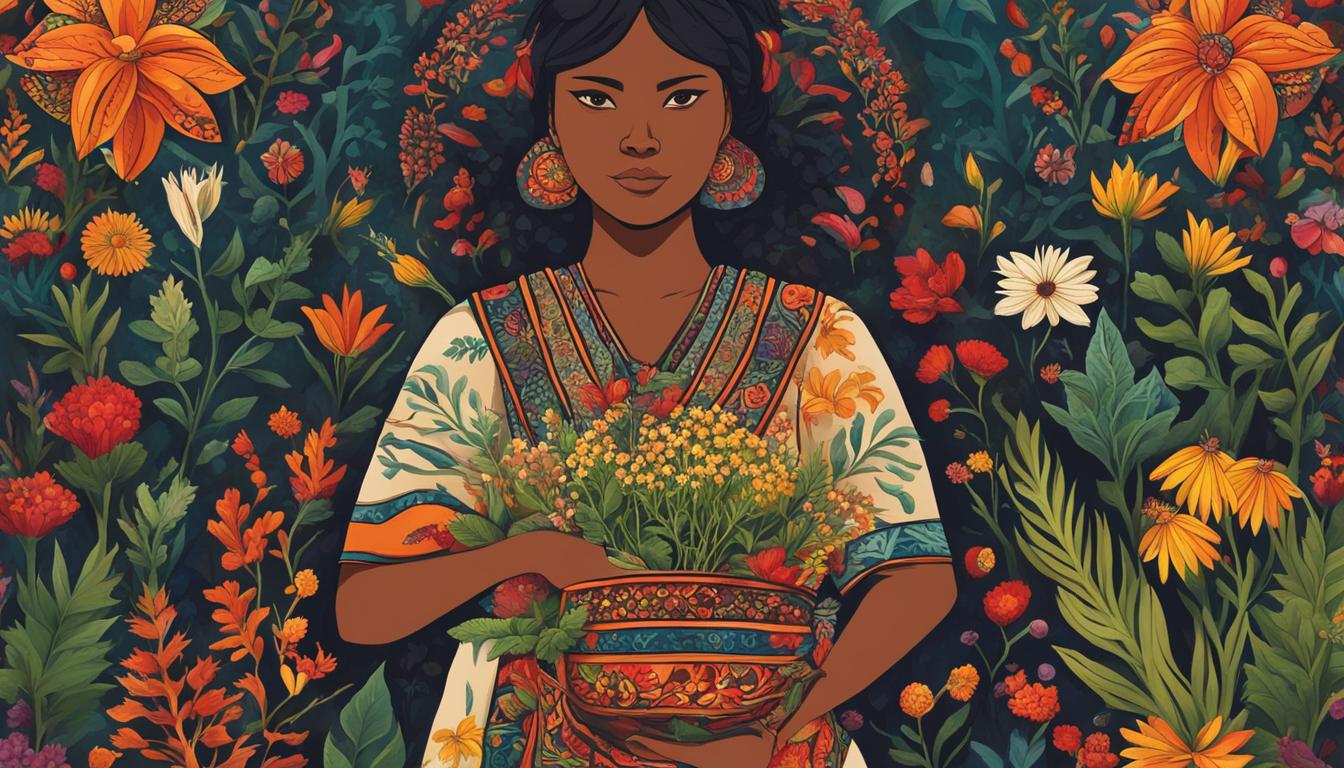
Healing with medicinal plants dates back to ancient times and is a practice that is prevalent in various cultures around the world. The use of plants for medicinal purposes has been documented in written texts, monuments, and historical records.
Throughout history, different civilizations recognized the active properties of plant-based drugs and incorporated them into their traditional healing practices. This widespread knowledge and awareness of the therapeutic benefits of medicinal plants have contributed to the development of modern pharmacotherapy.
Key Takeaways:
- Traditional uses of medicinal plants are rooted in ancient practices across different cultures.
- Medicinal plants have been documented in written texts, monuments, and historical records.
- Plant-based drugs are recognized for their active properties and incorporated into traditional healing practices.
- The knowledge of medicinal plants has led to the development of modern pharmacotherapy.
- Understanding the traditional uses of medicinal plants contributes to overall healthcare knowledge and practice.
History of Medicinal Plant Usage
The use of medicinal plants can be traced back to ancient civilizations, as documented by various historical sources. The Sumerians, for example, recorded recipes for drug preparation that involved over 250 different plant species, including alkaloid-rich plants like poppy, henbane, and mandrake.
Other ancient cultures like the Chinese, Indians, and Egyptians also had extensive knowledge of medicinal plants, as evidenced by their writings on the subject. The ancient Greeks, particularly renowned physician Hippocrates, classified and described around 300 medicinal plants based on their physiological actions.
Throughout history, medicinal plants have played a crucial role in healthcare, providing relief for various ailments. The knowledge of plant drugs and their usage was passed down through generations and formed the foundation of traditional healing practices in many cultures.
These practices involved the systematic gathering, preparation, and administration of plant-based remedies for therapeutic purposes.
Development of Plant-based Drugs
The use of medicinal plants not only influenced traditional healing practices but also contributed to the development of modern pharmacotherapy. Many of the active compounds found in medicinal plants served as the basis for the synthesis of pharmaceutical drugs.
For example, the pain-relieving properties of the opium poppy led to the development of opioid painkillers like morphine and codeine. Similarly, the antimalarial properties of the Cinchona tree bark inspired the synthesis of the widely used antimalarial drug quinine.
| Plant | Traditional Use | Modern Application |
|---|---|---|
| Opium Poppy | Pain relief | Opioid painkillers (Morphine, Codeine) |
| Cinchona Tree Bark | Antimalarial | Quinine (Antimalarial drug) |
| Willow Bark | Fever reduction, pain relief | Aspirin (Pain reliever, fever reducer) |
The historical usage of medicinal plants not only provides valuable insights into the therapeutic properties of various plant species but also highlights the potential for discovering new drugs from natural sources.
Many modern researchers are exploring traditional healing practices and studying the active compounds present in medicinal plants to develop novel treatments for various diseases.
Medicinal Plants in Different Cultures
Medicinal plants hold a significant place in the healing traditions of different cultures around the world. These plants have been used for centuries in various traditional practices, each with its unique approach and understanding of their therapeutic properties.
In this section, we will explore the traditional uses of medicinal plants in Chinese medicine, Indian Ayurveda, and Native American remedies.
Chinese Medicine
Chinese medicine, with its roots dating back thousands of years, has a deep appreciation for the healing power of plants. The ancient Chinese texts, such as the famous book “Pen T’Sao,” contain detailed information about the properties and uses of medicinal plants.
The book lists 365 drugs derived from medicinal plants that are still employed in Chinese medicine today. These plants are carefully selected, processed, and combined to create herbal remedies that aim to restore balance and promote health.
Indian Ayurveda
Ancient Indian Ayurveda, one of the oldest medical systems in the world, also relies heavily on medicinal plants. The holy books Vedas mention numerous plants for their healing properties.
Ayurvedic practitioners believe that every plant has unique energies and qualities that can be harnessed to treat various ailments. Herbal preparations, such as powders, decoctions, and oils, are created using specific plants to address imbalances and support overall well-being.
Native American Remedies
The Native American cultures have a rich tradition of using medicinal plants for healing purposes. Indigenous tribes across North America have long relied on the knowledge passed down from their ancestors to identify and utilize the medicinal properties of local plants.
Sage, cedar, tobacco, and many other plants hold sacred significance and are used in various remedies. These remedies often involve spiritual rituals and ceremonies, emphasizing the connection between mind, body, and nature.
| Medicine | Description |
|---|---|
| Chinese Medicine | An ancient medical system that uses a combination of herbal remedies, acupuncture, and other therapies to restore balance and promote well-being. |
| Indian Ayurveda | One of the oldest medical systems, Ayurveda focuses on maintaining overall health and harmony by using personalized herbal remedies, lifestyle practices, and dietary recommendations. |
| Native American Remedies | Traditional healing practices of indigenous tribes in North America, involving the use of sacred plants and rituals to promote physical, emotional, and spiritual well-being. |
Cultural Healing Practices
The traditional uses of medicinal plants are deeply ingrained in cultural healing practices. Ethnobotany, the study of how different cultures use plants for medicinal purposes, reveals the intricate knowledge and practices associated with traditional healing.
Traditional plant-based medicine encompasses a wide range of practices, including the preparation of herbal remedies, the use of specific plants for different ailments, and the incorporation of plants in rituals and ceremonies. These cultural healing practices reflect the unique beliefs and traditions of each culture.
Traditional Healing Methods
Traditional healing methods often involve a holistic approach that considers both the physical and spiritual aspects of health. In many cultures, healers play a crucial role in diagnosing and treating illnesses using a combination of medicinal plants and rituals.
The knowledge and techniques passed down through generations contribute to the effectiveness and cultural significance of these healing practices.
Interconnectedness of Nature and Health
One of the fundamental principles underlying cultural healing practices is the interconnectedness of nature and health. Traditional healers believe that plants have inherent healing properties and can restore balance within the body.
Plants are seen as allies in the healing process, providing not only physical relief but also emotional and spiritual well-being. This deep respect for nature and its healing powers is an integral part of cultural healing practices.
Preservation of Cultural Heritage
By recognizing and practicing cultural healing methods, communities are able to preserve their cultural heritage and maintain a connection to their ancestral traditions.
The transmission of knowledge from one generation to the next ensures that traditional healing practices continue to thrive. It also fosters a sense of identity and belonging within the community, strengthening cultural resilience and pride.
| Cultural Healing Practice | Description |
|---|---|
| Traditional Chinese Medicine | Involves the use of herbal remedies, acupuncture, and other techniques to restore the balance of Yin and Yang in the body. |
| Ayurveda | An ancient Indian system of medicine that focuses on balancing the body, mind, and spirit through the use of herbs, diet, and lifestyle practices. |
| Native American Medicine | Native American tribes have their own unique healing practices, often involving the use of sacred herbs and rituals to promote physical and spiritual well-being. |
| African Traditional Medicine | An integral part of many African cultures, traditional medicine in Africa incorporates the use of medicinal plants, spiritual practices, and rituals to treat various ailments. |
Contemporary Relevance of Medicinal Plants
Despite the advancements in modern medicine, the use of medicinal plants continues to hold contemporary relevance. With the increasing concerns about the efficacy and side effects of synthetic drugs, many individuals are turning to herbal medicines, natural drugs, and plant-based remedies as alternative or complementary treatments for various health conditions.
The traditional knowledge and uses of medicinal plants in different cultures have stood the test of time and are still valued today. These plant-based remedies offer a holistic approach to healthcare, considering the interconnectedness of the mind, body, and spirit.
By harnessing the healing properties of medicinal plants, individuals can tap into nature’s abundant pharmacy and explore alternative avenues for wellness.
Herbal medicines derived from medicinal plants are often sought after for their perceived safety and minimal side effects compared to pharmaceutical drugs.
They are believed to work in harmony with the body, supporting its natural healing processes. From teas and tinctures to poultices and essential oils, there is a wide range of plant-based remedies available that cater to various health needs and preferences.
| Benefits of Medicinal Plants | Examples |
|---|---|
| Anti-inflammatory properties | Turmeric, ginger |
| Immune-boosting effects | Echinacea, elderberry |
| Calming and stress-relieving | Chamomile, lavender |
| Digestive support | Peppermint, fennel |
Furthermore, the use of medicinal plants aligns with the growing trend of embracing natural and sustainable practices.
As people become more conscious of their impact on the environment, they are seeking out plant-based alternatives that are ethically sourced and don’t contribute to the depletion of resources.
This shift towards a more holistic and eco-friendly approach to healthcare is driving the continued appreciation and utilization of medicinal plants in contemporary society.
In conclusion, the traditional uses of medicinal plants have found relevance in modern times as people seek alternative and complementary treatments.
The availability of herbal medicines, natural drugs, and plant-based remedies provides individuals with a diverse range of options to support their health and well-being.
By acknowledging the power of nature’s pharmacy, we can harness the potential of medicinal plants while upholding sustainable practices for a healthier future.
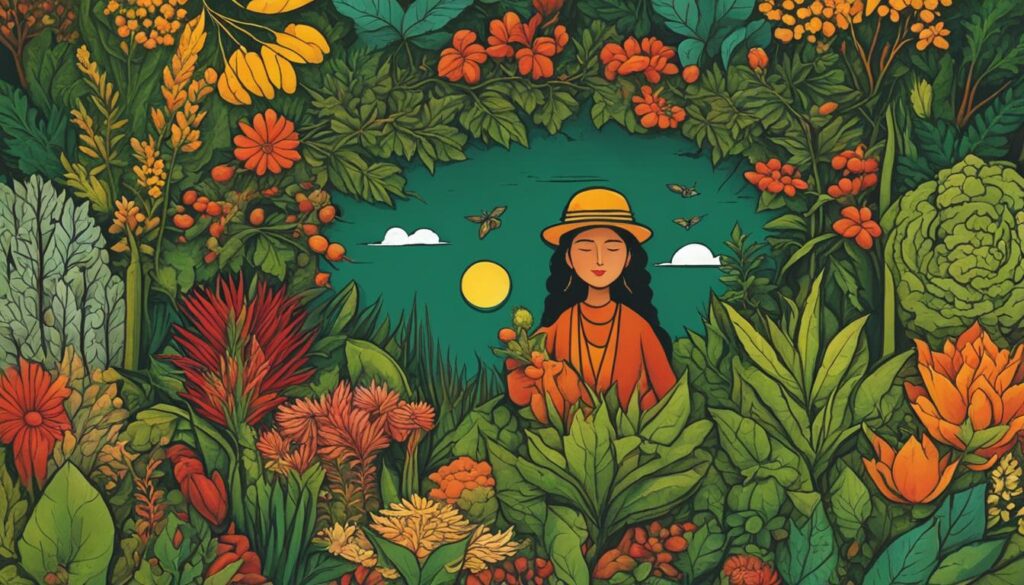
Medicinal Plants in Popular Culture
Traditional herbal remedies and the cultural references associated with medicinal plants have permeated popular culture, making appearances in various forms of media. Books, movies, and folklore often depict the significance and value of these remedies, showcasing their historical and cultural relevance.
Popular culture plays a crucial role in preserving and spreading knowledge about traditional herbal remedies. Many literary works highlight the traditional uses of medicinal plants, introducing readers to the healing properties of specific herbs and their cultural significance.
Films and television shows often incorporate these remedies into their storylines, creating a sense of intrigue and curiosity around the topic.
One example of medicinal plants in popular culture is the inclusion of herbs and potions in fantasy literature and movies. These depictions draw inspiration from real-world traditional healing practices and add an element of mystique to the narrative.
The portrayal of traditional herbal remedies in popular culture not only entertains but also educates the audience about the rich history and cultural heritage associated with these plants.
| Medium | Examples |
|---|---|
| Literature | – The inclusion of healing herbs in the Harry Potter series – The use of traditional remedies in books like “The Witcher” and “Outlander” – Herbal medicine and potions in fantasy novels |
| Movies | – The portrayal of traditional healing practices in films like “The Lion King” and “Moana” – The depiction of herbal remedies in movies like “The Princess Bride” and “Pan’s Labyrinth” |
| Folklore | – Legends and tales that involve the magical properties of specific medicinal plants – Stories that emphasize the healing abilities of herbs and their connection to nature |
Cultural References of Medicinal Plants in Popular Culture
These cultural references not only entertain audiences but may also spark an interest in traditional herbal remedies, fostering a deeper appreciation for the knowledge and practices of different cultures.
By preserving and promoting the cultural references of medicinal plants, popular culture helps ensure that these traditional uses continue to be valued and appreciated.
Traditional Uses of Medicinal Plants Today
Despite the advancements in modern medicine, the traditional uses of medicinal plants continue to hold significant relevance in contemporary society.
Many people still rely on traditional herbal remedies and alternative forms of medicine for various health conditions. These practices, rooted in cultural traditions, offer alternative or complementary approaches to modern medical treatments.
The modern applications of medicinal plants are vast and diverse. Herbal remedies derived from plants such as chamomile, ginger, and ginseng are commonly used for their calming, digestive, and immune-boosting properties.
These natural alternatives are valued for their ability to provide relief without the potential side effects associated with synthetic drugs.
In alternative medicine, traditional plant-based remedies are often used to address chronic conditions such as arthritis, respiratory ailments, and gastrointestinal issues. These practices recognize the holistic approach to healing, considering not only the physical symptoms but also the overall well-being of an individual.
The continued use of medicinal plants in modern times highlights the enduring wisdom and effectiveness of traditional healing practices. As more people seek natural and holistic approaches to healthcare, the importance of preserving and respecting the knowledge of medicinal plants becomes increasingly vital.
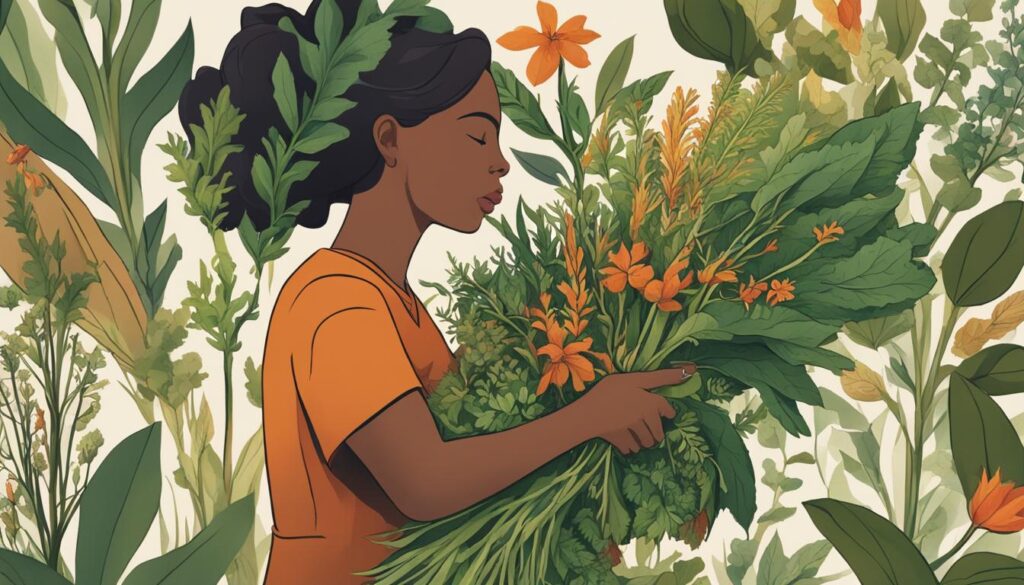
Comparative Analysis of Modern Applications
| Health Condition | Modern Application | Traditional Herbal Remedy |
|---|---|---|
| Anxiety and Stress | Prescription medication with potential side effects | Herbal teas or supplements with calming properties, such as chamomile or lavender |
| Indigestion | Over-the-counter antacids | Ginger or peppermint tea for soothing digestion |
| Respiratory Issues | Prescribed inhalers or bronchodilators | Herbal remedies with expectorant properties, such as eucalyptus or thyme |
| Joint Pain | Pain-relieving medications with potential long-term side effects | Turmeric or willow bark as natural anti-inflammatories |
Challenges and Future Prospects
The traditional uses of medicinal plants face several challenges in the modern world. One of the key issues is the conservation and sustainable use of plant resources.
Overharvesting and habitat destruction pose significant threats to many medicinal plants, potentially leading to their extinction. It is crucial to implement strategies that promote the conservation of these plants and ensure their long-term sustainability.
Another challenge lies in the standardization and regulation of traditional medicine. As the use of medicinal plants becomes more widespread, it is essential to establish guidelines and quality control measures to ensure the safety and efficacy of traditional remedies.
This will help build trust and credibility in traditional medicine practices and ensure the well-being of individuals who rely on these treatments.
Despite the challenges, there is growing recognition of the value of traditional knowledge and efforts to incorporate it into modern healthcare. Integrating traditional uses of medicinal plants with conventional medicine can lead to a more comprehensive and holistic approach to healthcare.
This recognition also contributes to the preservation and continuation of traditional healing practices, ensuring that future generations can benefit from the wisdom of their ancestors.
| Challenges | Solutions |
|---|---|
| Conservation and sustainable use of plant resources | Implement strategies for conservation, such as promoting sustainable harvesting practices, cultivating medicinal plants, and protecting their natural habitats. |
| Standardization and regulation of traditional medicine | Establish guidelines, quality control measures, and safety protocols to ensure the efficacy and safety of traditional remedies. |
| Integration of traditional medicine with modern healthcare | Encourage collaboration and knowledge exchange between traditional healers and modern healthcare practitioners to create a more comprehensive and holistic approach to healthcare. |
In conclusion, the challenges faced by traditional uses of medicinal plants require concerted efforts to address issues such as conservation, standardization, and integration with modern healthcare.
By implementing sustainable practices, establishing regulations, and fostering collaboration, we can ensure the preservation and continued relevance of traditional knowledge. The future prospects for medicinal plants lie in recognizing their value and harnessing their potential to contribute to human health and well-being.
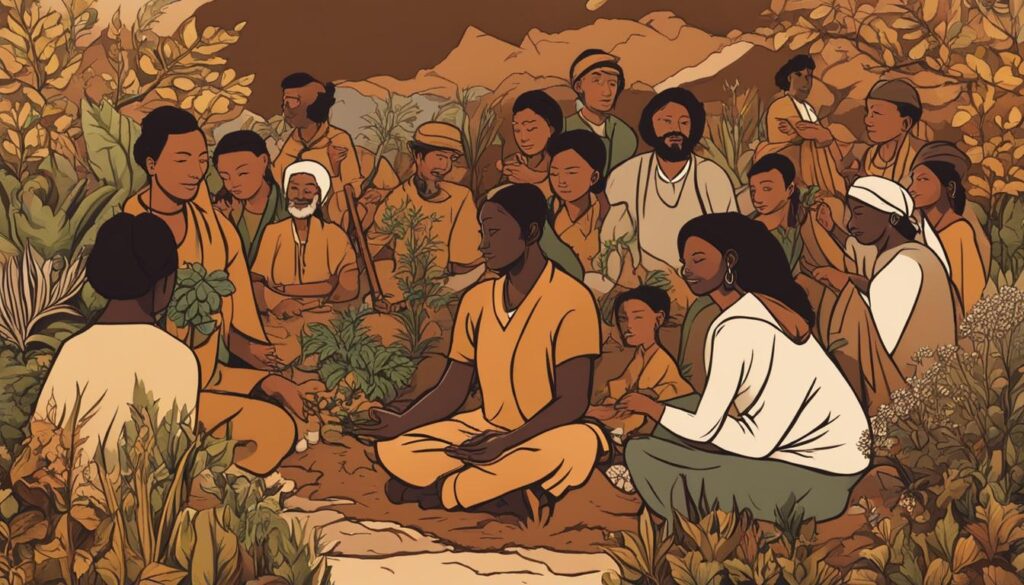
Tthe traditional uses of medicinal plants in different cultures have a long and rich history. These practices, deeply rooted in cultural traditions, continue to be valued today as alternative or complementary approaches to modern medicine.
The knowledge and practices associated with medicinal plants offer valuable insights into the potential of nature’s own pharmacy and should be recognized and respected for their contributions to human health and well-being.
However, the conservation and sustainable use of medicinal plants are crucial considerations for their future availability. Overharvesting and habitat destruction pose threats to many medicinal plants, potentially leading to their extinction. Efforts are needed to ensure the preservation of these valuable resources.
Despite the challenges, there is growing recognition of the value of traditional knowledge and efforts to incorporate it into modern practices. The integration of traditional medicine with modern healthcare ensures the continuation of traditional uses of medicinal plants.
As we move forward, it is important to strike a balance between preserving cultural traditions and ensuring the safety and efficacy of traditional medicines.
FAQ
What are the traditional uses of medicinal plants in different cultures?
The traditional uses of medicinal plants in different cultures encompass a wide range of practices, including the preparation of herbal remedies, the use of specific plants for different ailments, and the incorporation of plants in rituals and ceremonies.
What is the history of medicinal plant usage?
Healing with medicinal plants dates back to ancient times, with different civilizations recognizing the active properties of plant-based drugs and incorporating them into their traditional healing practices. Ancient texts and records document the use of medicinal plants by civilizations such as the Sumerians, Chinese, Indians, Egyptians, and Greeks.
How do different cultures use medicinal plants?
Different cultures have their own traditional uses of medicinal plants. For example, Chinese medicine places great emphasis on herbal remedies, Indian Ayurveda uses numerous plants for their healing properties as mentioned in the holy books Vedas, and Native American cultures have a rich history of using plants like sage, cedar, and tobacco for medicinal purposes.
What are cultural healing practices?
Cultural healing practices encompass the knowledge and practices associated with traditional plant-based medicine. This includes the preparation of herbal remedies, the use of specific plants for different ailments, and the incorporation of plants in rituals and ceremonies.
Are medicinal plants still relevant in contemporary society?
Yes, despite the advancements in modern medicine, there is a renewed interest in the use of medicinal plants. Many people are turning to herbal medicines and natural drugs as alternative or complementary treatments for various health conditions.
How are medicinal plants depicted in popular culture?
Medicinal plants and their traditional uses often make appearances in books, movies, and folklore, showcasing their significance and cultural value. Traditional herbal remedies, in particular, have gained attention and are featured in various forms of media.
Are traditional uses of medicinal plants still practiced today?
Yes, many people still rely on traditional herbal remedies and alternative forms of medicine for various health conditions. These practices have gained recognition and acceptance in some medical circles, leading to the integration of traditional knowledge with modern healthcare.
What are the challenges and future prospects of traditional uses of medicinal plants?
The conservation and sustainable use of plant resources is a key challenge, as overharvesting and habitat destruction pose threats to many medicinal plants. Another challenge is the standardization and regulation of traditional medicine to ensure safety and efficacy. Efforts are being made to incorporate traditional knowledge into modern practices to ensure the continuation of traditional uses of medicinal plants.
What is the conclusion regarding the traditional uses of medicinal plants?
The traditional uses of medicinal plants in different cultures have a long and rich history. They continue to be practiced and valued today, providing alternative or complementary approaches to modern medicine. The knowledge and practices associated with medicinal plants are deeply rooted in cultural traditions and play a significant role in healthcare. The conservation and sustainable use of medicinal plants are important considerations for their future availability. The traditional uses of medicinal plants offer valuable insights into the potential of nature’s own pharmacy and should be recognized and respected for their contributions to human health and well-being.





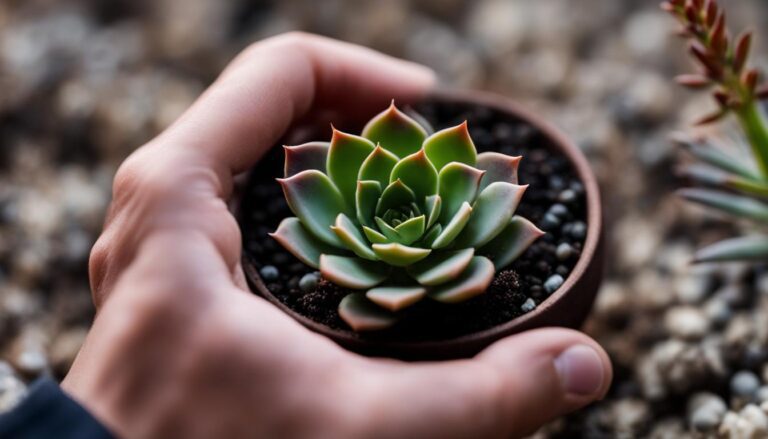

2 Comments
Comments are closed.